About Bolivia
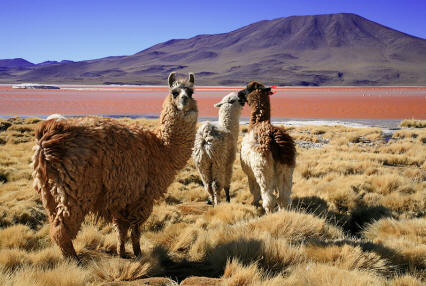
Photo courtesy of András Janscik
Bolivia, the world's largest producer of tin, is located at the very center of South America. Unfortunately, it is among continent's poorest countries with 64% of its 9 million people living in poverty.
You can zoom in on this Expedia Map and see details down to the names of small towns. There are several types of maps at WorldAtlas.com, and a very detailed collection at the University of Texas.
Habitat for Humanity has been active in Bolivia since 1985, and now serves the country through 9 affiliates building over 600 houses per year according to the http://www.habitat.org/intl/lac/24.aspxBolivia profile at Habitat for Humanity International.
Here is an http://www.habitat.org/hw/dec_2008/feature3f.htmlarticle about one Bolivian family's Habitat home ownership experience.
Get a tourist view at Viva Travel Guides.
Here is a profile from BBC News.
The CIA World Factbook contains a multitude of information.
The official currency is the Bolivian Boliviano. The average exchange rate from August 2006 through August 2007 has been 8.2 Bolivianos per US Dollar, with easing to a level of 7.9 in late August 2007.
Bolivia - The Heart Of South America
This profile was provided by the offices of Habitat for Humanity Bolivia
Geographic location
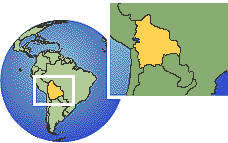
Bolivia is nestled deep in the heart of South America, sharing borders to the north and east with Brazil, to the west with Peru and Chile, and to the south with Paraguay and Argentina.
History of Bolivia
Archaeological evidence indicates that towards the year 2500 B.C. the first cultures had begun to appear in the area of South America now known as Bolivia.
One of the most fascinating and mysterious of these cultures was the Tiahuanacos. The Tiahuanacota hegemony was based on military power maintained by a disciplined army heavily supplied with bronze weaponry.
The Tiahuanacota Empire later disappeared due to serious climatic problems that caused a rapid decrease in both harvests and populations, and was later replaced by the "señorío" or kingdom of the Colla or Collasuyo, which was characterized by its advanced architectural techniques, especially in religious monuments. The Collasuyo was later conquered by the Incas.

After several indigenous revolts incited to rebellion in Alto, Peru, Bolivar and Sucre (political liberators) united by an ideal, and with their brave armies in tow, crossed plains, valleys, and mountains, swords raised to release the oppressed towns of South America. In the battles of Junín and Ayacucho, they then forged the Bolivian nation that we now know today.
Bolivia is often characterized by its diversity of flora and fauna, as well as its parallel diversity of culture. There are many different ethnic groups in Bolivia, which are divided into two main branches: the Andean group, which settled in altiplano and valley regions of Bolivia, and those of the warmer regions. There are many other ethnic groups in Bolivia, each with their own unique characteristics, and all are part of the historical-cultural antecedents of the country.
Among these smaller sub-groups are: in the valleys, the Yampara or Ampara and the Mojocoyas; in the Eastern Zone, the Chiriguanos, Guarayos, Moxeños, Chapacuras, Itonomas, Movimas, Paraguaras, Iténez, Tacanas, Mosetenes and Sirionós.
The mountain range of the Andes crosses through Bolivia, providing numerous peaks and mountainous areas.
Mountain ranges and higher Mountains of Bolivia
|
Name |
Department |
Meters (above sea level) |
Feet (above sea level) |
|
Sajama |
Oruro |
6.542 |
21.464 |
|
Illampu |
La Paz |
6.421 |
21.067 |
|
Illimani |
La Paz |
6.402 |
21.006 |
|
Hanko Uma |
La Paz |
6.380 |
20.933 |
|
Chiaraco |
La Paz |
6.240 |
20.473 |
|
Pomerape |
Oruro |
6.222 |
20.414 |
|
Chachacomani |
La Paz |
6.150 |
20.178 |
Significant Lakes
|
Name |
Department |
Area Km2 |
Altitude (mts. above sea level) |
|
Titicaca |
La Paz |
8.030 |
3.810 |
|
Poopó |
Oruro |
1.337 |
3.686 |
|
Huaynatunas |
Beni |
360 |
200 |
|
Rogagua |
Beni |
350 |
200 |
Main salt esplanades
|
Name |
Department |
Area Km2 |
Altitude (mts. above sea level) |
|
Uyuni |
Potosí |
10.582 |
3.656 |
|
Coipasa |
Oruro |
2.218 |
3.680 |
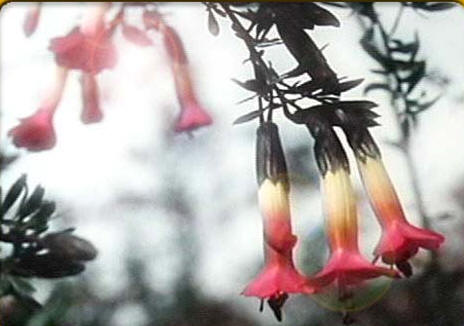
|
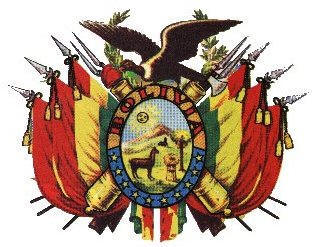
|

|
| National Flower- Kantuta | National Shield | National flag |
POPULATION DEMOGRAPHICS
Bolivia has a population of 8,274,325 inhabitants.
4.150.475 are women, representing 50.16% of the population
4,123,850 are men, representing 49,84% of the population
62.43% of the population (5,165,882 inhabitants) lives in urban areas, leaving 37.57% (3,108,443 inhabitants) residing in the rural areas.
58 - 60 % of the population lives beneath the poverty line.
Population per department
|
Department |
Inhabitants |
|
Chuquisaca |
531.522 |
|
La Paz |
2.350.466 |
|
Cochabamba |
1.455.711 |
|
Oruro |
391.870 |
|
Potosí |
709.013 |
|
Tarija |
391.226 |
|
Santa Cruz |
2.029.471 |
|
Beni |
362.521 |
|
Pando |
52.525 |
Source: INE
TERRITORIAL AREA
Bolivia has a territorial area of 1.098.581 Km2
|
Departure |
Area Km2 |
Height in meters |
|
Chuquisaca |
51.524 |
2.790 |
|
La Paz |
133.985 |
3.640 |
|
Cochabamba |
55.631 |
2.558 |
|
Oruro |
53.588 |
3.709 |
|
Potosí |
118.218 |
4.070 |
|
Tarija |
37.623 |
1.866 |
|
Santa Cruz |
370.621 |
416 |
|
Beni |
213.564 |
236 |
|
Pando |
63.827 |
221 |
HOUSING
A percentage equivalent to 4,695,464 inhabitants live in houses that do not fulfill the appropriate sanitary conditions.
|
Types of Housing in Bolivia
|
Number of People per Room
|
LANGUAGES
The official language in Bolivia is Spanish, nevertheless quechua, aymara and guaraní are also spoken.
INTERNATIONAL AREA CODE
The international calling code for Bolivia is 591.
CURRENT PRESIDENT
Evo Morales Ayma
SEASONS IN BOLIVIA
Spring September 21st to December 20th
Summer December 21st to March 20th
Autumn March 21st to June 20th
Winter June 21st to September 20th
HABITAT FOR HUMANITY BOLIVIA
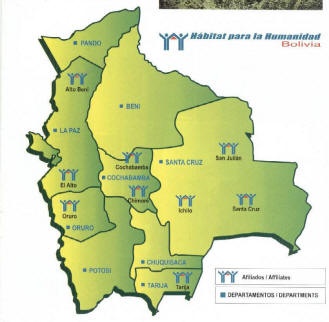
Habitat for Humanity Bolivia (HPHB) has built more than 6,204 houses since its inception in December 2005. Habitat Bolivia currently builds out of 9 Affiliate offices throughout the country: Alto Beni, El Alto, Cochabamba, Chimoré, Santa Cruz, San Julian, Ichilo, Oruro and Tarija.
Habitat Bolivia is working through several different Projects in order to reach the populations most readily in need of shelter, which has led to the development of the "Progressive" house model. With this design, the family is able to build the in several individual progressions, as they return portions of the loan granted by Habitat Bolivia. In this way, discrimination can be better eliminated towards lower income families.
The first, and main module is 60m2 (646 ft2), and consists of sub modules (A-B-C-D), which will follow norms and requirements for living space (kitchen, bathroom, living room and bedrooms 1- 2 -3).

 Who
Who